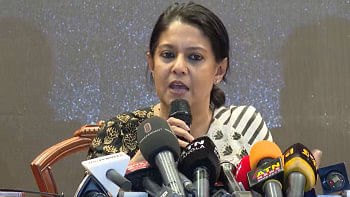A slice of Pakistan’s cultural and historical heritage

The High Commission for Pakistan in Dhaka arranged an exhibition titled "Pakistan: The Land of Indus" on Saturday at the Pakistan House. The event was organised as part of the diamond jubilee celebrations of Pakistan.
The exhibition highlighted exquisite calligraphies, artifacts, and coffee tables from Pakistan. The event also showcased artworks curated by Pakistan's High Commissioner to Bangladesh, Imran Ahmed Siddiqui.

Prominent artists, academics, representatives of the diplomatic corps, the Pakistani diaspora in Bangladesh, and local journalists were present at the event.

The exhibition featured 40 beautifully drawn Arabic calligraphies, miniature paintings, and replicas of sculptures from the Indus Valley civilisation, which are from the period of 3000 to 2000 BC. The coffee tables showcased an array of 50 books, which beautifully encapsulate the tales of Pakistan's rich and diverse culture.
Some notable books on the coffee table included "Folk heritage of Pakistan", "Pearls of Calligraphy", and "Buddhist Gandhara Treasures Taxila Museum".
"This event features my private collection, which I have been collecting over the past 10 years. My collection covers aspects of South Asian tradition and Islamic tradition such as calligraphy, which is a fundamental expression of art for Muslims all over the world," said Imran Ahmed Siddiqui, High Commissioner for Pakistan, Dhaka.

"The exhibition also features works by Pakistani calligrapher, Shafiq-Uz-Zaman-Khan, the Chief Calligrapher of the Prophet's mosque. It also explores Pakistan's pre-Islamic heritage which includes Buddhism and Hinduism found in the ancient Indus valley," added Imran Ahmed Siddiqui.
The intricate detailing of the "Clay Male Torso" found over 3000 years ago at Harappa marks the beginning of human settlement in Pakistan.
Another beautiful artifact is the "Fasting Siddhartha", which captures the tale of the Buddha finally achieving nirvana. The original artifact is currently preserved in the Lahore museum. However, you can easily see the details in the replica version, as can be seen by the ribs of the sculpture being on display to showcase the Buddha's fasting.

Traditional miniature paintings from the Mughal period were also on display at the exhibition. A magnifying glass is tied next to the paintings, and you can look through it to observe the immaculate details and strokes of colour which are weaved beautifully in the painting to showcase the tale of the Mughal processions and their aesthetic traditions.
The event had a huge array of calligraphies starting with Rana Riaz Ahmed's work which used the technique of 'pointillism' to evoke the elegance of Quranic verses.
Another work of calligraphy that was quite brilliant, was M A Bukhari's colourful calligraphy. Here, the calligrapher used the cubic technique and vibrant colours to attract viewers.
The exhibition gives an in-depth view of the rich history and culture residing at the heart of Pakistan. It celebrates the amalgamation of a variety of art forms and styles that have become immortalised over the years.


 For all latest news, follow The Daily Star's Google News channel.
For all latest news, follow The Daily Star's Google News channel. 



Comments